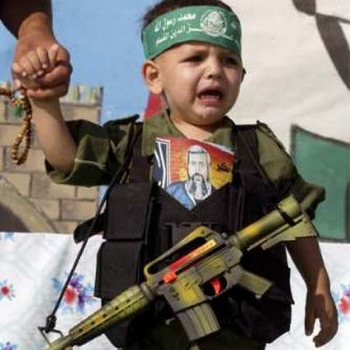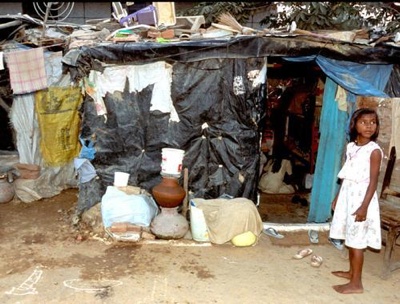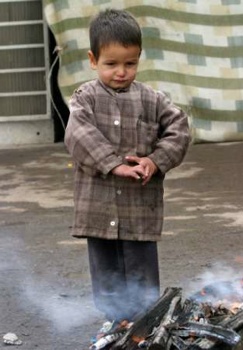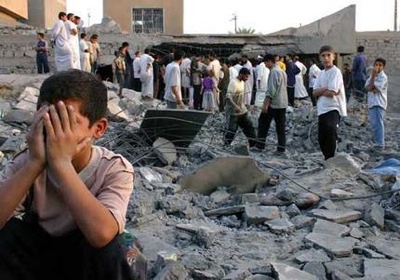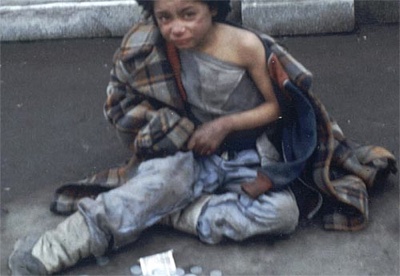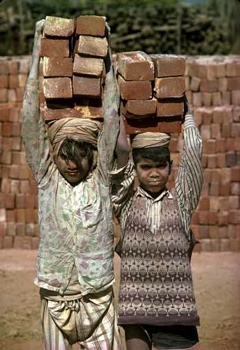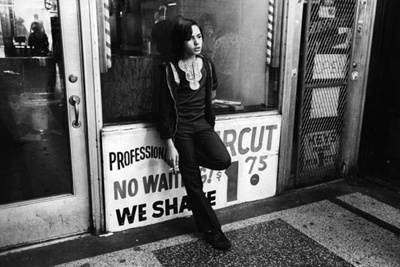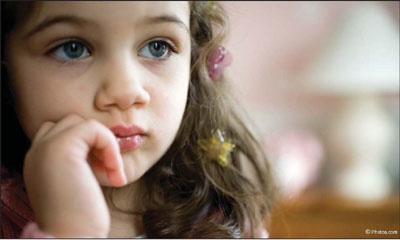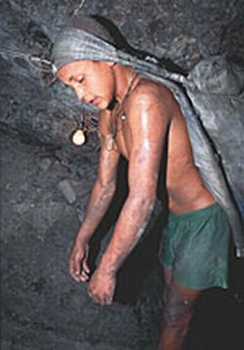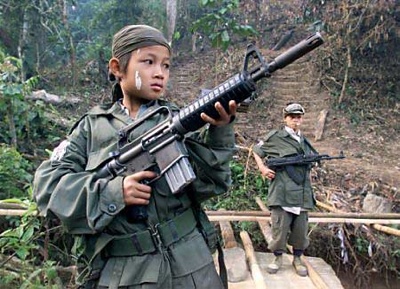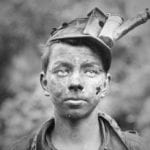Palestinian children are taught to hate Jews, to glorify “jihad” (holy war), violence, death and child martyrdom almost from birth, as an essential part of their culture and destiny. As captured on an Israeli video documentary produced in 1998, a “Sesame Street”-like children’s program called the “Children’s Club” — complete with puppet shows, songs, Mickey Mouse and other characters — focused on inculcating intense hatred of Jews and a passion for engaging in and celebrating violence against them in a perpetual “jihad” until the day the Israeli flags come down from above “Palestinian land” and the Palestinian flag is raised. In Madrasas, Islamic schools for study of pure Islamic religion, the culprits are the religious teachers; and the victims include helpless innocent underage students. The sacred teacher-student relationship is given a new definition in these Islamic schools. Following is the bitter experience of a 12 years old madrasa student from Kenya who was rescued during January 2003. Chaining incidents are rare in Bangladeshi madrasas. Child torture incidents in madrasas are reported mostly in Pakistan, Afghanistan and Sudan. The number of students are estimated somewhere between eight hundred thousands to one million. They are often run by religious organizations and lure young children mainly from poor families by providing free food and lodging. Some of the schools even provide intensive political and armed training.
According to UNICEF, 25,000 children die each day due to poverty. Around 27-28 percent of all children in developing countries are estimated to be underweight or stunted. The two regions that account for the bulk of the deficit are South Asia and sub-Saharan Africa. Some 1.1 billion people in developing countries have inadequate access to water, and 2.6 billion lack basic sanitation. Almost two in three people lacking access to clean water. Some 1.8 million child deaths each year as a result of diarrhea. For the 1.9 billion children from the developing world, there are: 640 million without adequate shelter (1 in 3), 400 million with no access to safe water (1 in 5) and 270 million with no access to health services (1 in 7). 10.6 million died in 2003 before they reached the age of 5 (same as children population in France, Germany, Greece and Italy.) 1.4 million die each year from lack of access to safe drinking water and adequate sanitation. 2.2 million children die each year because they are not immunized. Millions of parents in developing countries must daily cope with the fact that their children may not survive the first critical years of life; in many cases, the diseases that threaten their children’s lives are preventable.
Of the 50 million refugees and displaced people in the world, approximately half are children. War is the primary factor in the creation of child refugees. It is also a principle cause of child death, injury, and loss of parents. In the last decade, war has killed more than 2 million children, wounded another 6 million, and orphaned about 1 million. Children also flee their homes because they fear various forms of abuse such as rape, sexual slavery, and child labor. Circumstances of birth also play a role in depriving children of a legal home. Each year 40 million children are not registered at birth, depriving them of nationality and a legal name. The combined ravages of AIDS and war have created a large pool of orphan refugees and displaced children, particularly in Africa. The toll of Rwanda’s civil war, for example, left orphan children to head some 45,000 Rwandan households, with 90 percent of these headed by girls. “Separated Children” are those under age 18 and living outside their country of origin without parents or legal guardians to care for or protect them. Every year, about 20,000 separated children apply for asylum in Europe and North America. Overall, children account for approximately half of all individuals seeking legal asylum in developed countries. Separated children are not often legally recognized as refugees in western countries. In Europe, for example, where there may be as many as 50,000 separated children at any given time, only an estimated 1-5 percent of those who apply for asylum are granted refugee status.
More than 100 million children do not have access to school. Of the children who enroll in primary school, over 150 million drop out, while user fees, including levies, are still charged for access to education in 92 countries and that such charges have impact on excluding girls. 77 million children worldwide are not able to go to school due to lack of funds. For socially disadvantaged segments of the population like poor inhabitants of cities, AIDS orphans and the physically challenged, any access to education is often particularly difficult to obtain. The consequence of this lack of access to education is that 15 percent of those adolescents between 15 and 24 in third world countries are illiterate. Location often contributes to a child’s lack of access and attendance to education. In certain areas of the world it is more difficult for children to get to school. For example, in high-altitude areas of India, severe weather conditions for more than 7 months of the year make school attendance erratic and force children to remain at home. Gender also contributes to a child’s lack of access and attendance to education. In 25 countries the proportion of boys enrolling in secondary school is higher than girls by 10% or more, and in five; India, Nepal, Togo, Turkey and Yemen, the gap exceeds 20%. The worst disparity is found in South Asia, where 52% of boys and only 33% of girls enroll; a gap of 10%. Enrollment is low for both boys and girls in sub-Saharan Africa, with rates of just 27% and 22%. Girls trail respectively behind. It is generally believed that girls are often discouraged from attending primary schooling, especially in less developed countries for religious and cultural reasons.
Neglect is an act of omission, or the absence of action. While the consequences of child neglect can be devastating, it leaves no visible marks. Moreover, it usually involves infants and very young children who cannot speak for themselves. James M. Gaudin Jr., in “Child Neglect: Short-Term and Long-Term Outcomes”, reported that, compared with non-maltreated and abused children, neglected children have the worst delays in language comprehension and expression. Psychologically neglected children also score lowest in IQ (Intelligence Quotient) tests. Emotional neglect, in its most serious form, can result in the “non-organic failure to thrive syndrome,” a condition in which a child fails to develop physically or even to survive. According to Gaudin, studies have found that, even with aggressive intervention, the neglected child continues to deteriorate. The cooperation of the neglectful parents, which is crucial to the intervention, usually declines as the child’s condition worsens. This shows that it is sometimes not that easy to change the parental attributes that have contributed to the neglect in the first place. Parental neglectful behaviors include not keeping the child clean, not providing enough clothes for keeping warm, not making sure the child attended school, not caring if the child got into trouble in school, not helping with homework, not helping the child do his best, not providing comfort when the child was upset, and not helping when the child had problems. The prevalence of childhood neglect ranged from 3.2% in New Hampshire, United States, to 10% in Montreal, Quebec, Canada, 19.4% in Singapore, and 36.4% in Pusan, Korea.
An estimated 211 million children between the ages of 5 and 14 are working around the world, according to the International Labor Organization. Of these, 120 million children are working full time to help support their impoverished families. There are millions of children whose labor can be considered forced, not only because they are too young to choose to work, but also because they are, in fact, actively coerced into working. These include child bonded laborers — children whose labor is pledged by parents as payment or collateral on a debt — as well as children who are kidnapped or otherwise lured away from their families and imprisoned in sweatshops or brothels. In addition, millions of children around the world work unseen in domestic service — given or sold at a very early age to another family. Forced child laborers work in conditions that have no resemblance to a free employment relationship. They receive little or no pay and have no control over their daily lives. They are often forced to work beyond their physical capacity and under conditions that seriously threaten their health, safety and development. In many cases their most basic rights, such as freedom of movement and expression, are suppressed. They are subject to physical and verbal abuse. Even in cases where they are not physically confined to their workplace, their situation may be so emotionally traumatizing and isolating that once drawn into forced labor they are unable to conceive of a way to escape.
In Thailand, NGOs have estimated that up to a third of prostitutes are children under 18. A study by the International Labor Organization on child prostitution in Vietnam reported that incidence of children in prostitution is steadily increasing and children under 18 make up between 5 percent and 20 percent of prostitution depending on the geographical area. In the Philippines, UNICEF estimated that there are 60,000 child prostitutes and many of the 200 brothels in the notorious Angeles City offer children for sex. In India as many as 200,000 Nepali girls, many under the age of 14, have been sold into red-light districts. Nepalese girls, especially virgins, are favored in India because of their fair skin and young looks. Every year about 10,000 Nepalese girls, most between the age of nine and 16, are sold to brothels in India. In El Salvador, one-third of the sexually exploited children between 14 and 17 years of age are boys. The median age for entering into prostitution among all children interviewed was 13 years.
The internet is a virtual playground for child predators. It is a place that operates largely outside of the law. While trading in pedophile pornography is illegal, lack of adequate funding means law enforcement officials are able to investigate just two percent of their leads. Also, according to Interpol statistics, only one-half of one percent are ever prosecuted. On a show that aired September 2, 2008, Oprah Winfrey showed a map that clearly conveyed how fast one pornographic image of a child being molested can spread. From a computer in Washington, DC, the image spread within 24 hours, all across the United States. The demand for new images and videos is so high that authorities report they are tracking increasingly brutal pornography with younger and younger victims.
Trafficking is the fastest growing means by which people are forced into slavery. It affects every continent and most countries. Currently, children are trafficked from countries such as Bangladesh, Pakistan, Sudan and Yemen to be used as camel jockeys in the UAE. Furthermore, Anti-Slavery International also has evidence that children are also being trafficked to be used as camel jockeys in other Gulf states including Kuwait, Qatar, Oman, and also internally in Sudan. The use of children as jockeys in camel racing is itself extremely dangerous and can result in serious injury and even death. Some children are also abused by the traffickers and employers, for example by depriving them of food and beating them. The children’s separation from their families and their transportation to a country where the people, culture and usually the language are completely unknown leaves them dependent on their employers and de facto forced laborers. According to UNICEF, over 200,000 children work as slaves in West and Central Africa. Boys are usually sold to work on cotton and cocoa plantations while girls are used as domestic servants and prostitutes. In some cases, children are kidnapped outright and sold into slavery while in others, families sell their children, mostly girls, for as little as $14.
Around the world, children are singled out for recruitment by both armed forces and armed opposition groups, and exploited as combatants. Approximately 250,000 children under the age of 18 are thought to be fighting in conflicts around the world, and hundreds of thousands more are members of armed forces who could be sent into combat at any time. Although most child soldiers are between 15 and 18 years old, significant recruitment starts at the age of 10 and the use of even younger children has been recorded. Easily manipulated, children are sometimes coerced to commit grave atrocities, including rape and murder of civilians using assault rifles such as AK-47s and G4s. Some are forced to injure or kill members of their own families or other child soldiers. Others serve as porters, cooks, guards, messengers, spies, and sex slaves.
